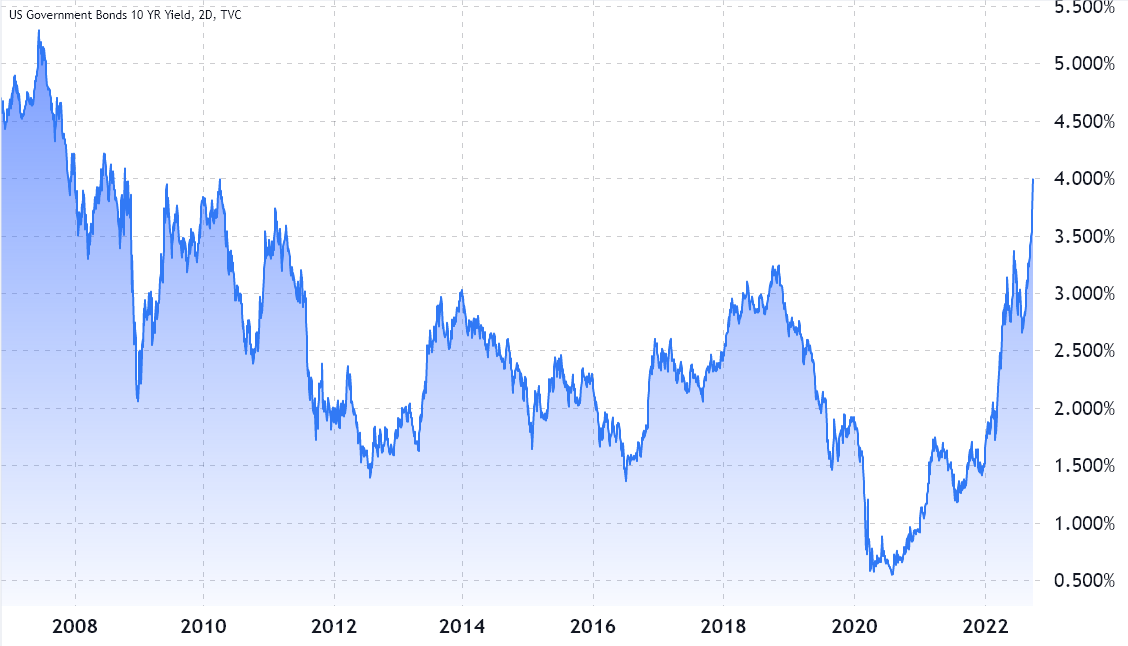The 10-year U.S. Treasury yield recently hit its highest level in 12 years, but how would possibly this impact investors’ sentiment toward stocks and cryptocurrencies?

Across all tradeable markets and currencies, U.S. Treasurys — government bonds — have important influence. In finance, any risk measurement is relative, meaning, if one insures a house, the utmost liability is ready in some form of money.
Similarly, if a loan is taken from a bank, the creditor has to calculate the odds of the money not being came back and also the risk of the quantity being devalued by inflation.
In a worst-case scenario, let’s imagine what would happen to the prices associated with issuance debt if the U.S. government briefly suspended payments to specific regions or countries. Currently, there's over $7.6 trillion value of bonds command by foreign entities, and multiple banks and governments rely upon this income.
The potential cascading result from countries and money establishments would in real time impact their ability to settle imports and exports, resulting in further carnage within the disposal markets as a result of each participant would rush to reduce risk exposure.
There is over $24 trillion in U.S. Treasurys command by the overall public, therefore participants typically assume that very cheap risk in existence is a government-backed debt title.
Treasury yield is nominal, so mind the inflation
The yield that's widely coated by the media isn't what skilled investors trade, as a result of every bond has its own worth. However, based on the contract maturity, traders will calculate the equivalent annualized yield, making it easier for the overall public to know the benefit of holding bonds. for example, shopping for the U.S. 10-year Treasury at ninety entices the owner with a similar 4-dimensional yield till the contract matures.

If the investor thinks that the inflation won't be contained anytime shortly, the tendency is for those participants to demand a better yield once trading the 10-year bond. On the opposite hand, if different governments are running the danger of turning into insolvent or hyperinflating their currencies, odds are those investors can get shelter in U.S. Treasurys.
A delicate balance permits the U.S. government bonds to trade lower than competitive assets and even run below the expected inflation. though inconceivable many years agone, negative yields became quite common when central banks slashed interest rates to zero to spice up their economies in 2020 and 2021.
Investors are paying for the privilege of getting the safety of government-backed bonds rather than facing the danger from bank deposits. As crazy because it might sound, over $2.5 trillion value of negative-yield bonds still exist, that does not consider the inflation impact.
Regular bonds are pricing higher inflation
To understand however disconnected from reality the U.S. government bond has become, one must realize that the three-year note’s yield stands at 4.38%. Meanwhile, client inflation is running at 8.3%, thus either investors assume the federal reserve can successfully ease the metric or they're willing to lose purchasing power in exchange for the lowest-risk asset in the world.
In modern history, the U.S. has never defaulted on its debt. In simple terms, the debt could be a voluntary limit. Thus, Congress decides what proportion debt the federal government will issue.
As a comparison, an HSBC Holdings bond maturing in August 2025 is commerce at a five.90% yield. primarily, one shouldn't interpret the U.S. Treasury yields as a reliable indicator for inflation expectation. Moreover, the actual fact that it reached the very best level since 2008 holds less significance as a result of knowledge shows investors are willing to sacrifice earnings for the protection of owning the lowest-risk quality.
Consequently, the U.S. Treasury yields are an excellent instrument to live against alternative countries and company debt, however not in absolute terms. Those government bonds can mirror inflation expectations however may even be severely capped if the generalized risk on alternative issuers will increase.
( Marcel Pechman, Cointelegraph, 2022 )
